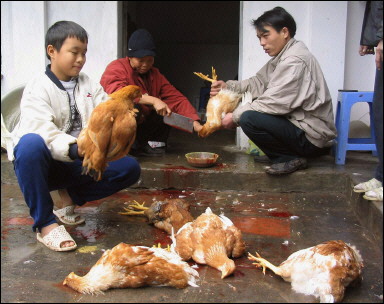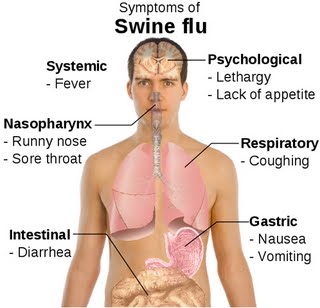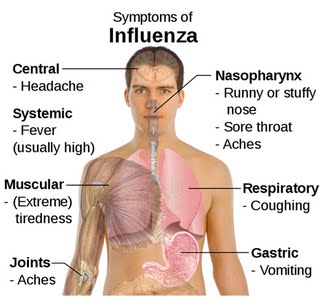2009-11-18
FLU FACTS: Know What you’re Talking About!
With Avian and Swine Flu dominating cable news broadcasts for the last few winters, people are a little more familiar with how the flu works. It’s now fairly well known that the flu comes from various viral varieties, not just one type of virus. Specifically, [NERD ALERT] Influenza, commonly known as the flu, is a general term referring to a contagious respiratory disease that is caused by several different viruses in the Orthomyxoviridae family.
Although the majority of the nation knows a little more about the flu than their grandmother did, there’s still a lot of room for confusion. Cable news flu coverage is simultaneously chock full of specific terminology and vague medical terms. It can get confusing quick! Here’s a little fact sheet to help clear the haze:
EPIDEMIC – The rapid spread of a disease that affects some or many people in a community or region at the same time. (Spreads quickly, effects locally)
PANDEMIC – An outbreak of a disease that affects large numbers of people throughout the world and spreads rapidly. (Spreads quickly, effects globally)
INFLUENZA A – Flue viruses are broken down into three divisions; Influenza A, Influenza B, and Influenza C. Influenza A strains appear in several types of animals, including human. Yes, along with Bird and Swine Flu, there is a Human Flu. Human Flu in humans is the typical seasonal flu that comes around every year. It’s bad, but manageable. The problem with Influenza A viruses arise when animal strains mutate and/or transfer over into the human population.
 H5N1 – “Avian Flu/ Bird Flu” H5N1 is a strain of Influenza A that usually effects only birds. The virus can cause epidemics in bird populations, decimating entire poultry farms. 1997, a Hong Kong boy was the first human to be effected by H5N1. An outbreak that began in 2003 has infected over 250 people in 10 countries. More than half of them have died, demonstrating just how deadly H5N1 is to humans.
H5N1 – “Avian Flu/ Bird Flu” H5N1 is a strain of Influenza A that usually effects only birds. The virus can cause epidemics in bird populations, decimating entire poultry farms. 1997, a Hong Kong boy was the first human to be effected by H5N1. An outbreak that began in 2003 has infected over 250 people in 10 countries. More than half of them have died, demonstrating just how deadly H5N1 is to humans.
As of now, H5N1 can only be spread from infected birds to humans, not from humans to other humans. However, H5N1 mutates and changes very rapidly, so it has a high potentiality of mutating into a virus that can be spread from human to human.

H1N1 – “Swine Flu” H1N1 is like H5N1 in that they are both Influenza A strains that originated in non-human animals, but is unlike H5N1 in that it is now easily communicable between humans.H5N1 was first detected in its human-human state in April 2009. On June 11th 2009, the World Health Organization signaled that a pandemic of H1N1 was underway. There is now an H1N1 flu shot, but supplies are still limited. In order to help control this pandemic, those who suspect they may have H1N1 should stay home, and contact a doctor.
INFLUENZA B – Unlink Influenza A which effects a variety of different animals, Influenza B affects only humans and seals (weird, right?). Because Influenza B has been around plaguing humans for ages, we know how to combat it.

SEASONAL FLU - The good old fashioned flu you grew up with. “A contagious respiratory illness cause by Influenza (flu) viruses occurring every year. It affects an average of 5 to 20 percent of the US population by causing mild to severe illness, and in some instances can lead to death. Adults may be able to infect others 1 day before getting symptoms and as long as 5 days after getting sick.” Different strains of Human Influenza A and Influenza B are what give us the seasonal flu we know and love… or hate. The seasonal flu shot contains weakened strains of both Influenza A and Human Influenza B.
Well, I hope that my explanations of these flu terms will help you get a better understanding of the flu—A key part of staying healthy.
Although the majority of the nation knows a little more about the flu than their grandmother did, there’s still a lot of room for confusion. Cable news flu coverage is simultaneously chock full of specific terminology and vague medical terms. It can get confusing quick! Here’s a little fact sheet to help clear the haze:
EPIDEMIC – The rapid spread of a disease that affects some or many people in a community or region at the same time. (Spreads quickly, effects locally)
PANDEMIC – An outbreak of a disease that affects large numbers of people throughout the world and spreads rapidly. (Spreads quickly, effects globally)
INFLUENZA A – Flue viruses are broken down into three divisions; Influenza A, Influenza B, and Influenza C. Influenza A strains appear in several types of animals, including human. Yes, along with Bird and Swine Flu, there is a Human Flu. Human Flu in humans is the typical seasonal flu that comes around every year. It’s bad, but manageable. The problem with Influenza A viruses arise when animal strains mutate and/or transfer over into the human population.
 H5N1 – “Avian Flu/ Bird Flu” H5N1 is a strain of Influenza A that usually effects only birds. The virus can cause epidemics in bird populations, decimating entire poultry farms. 1997, a Hong Kong boy was the first human to be effected by H5N1. An outbreak that began in 2003 has infected over 250 people in 10 countries. More than half of them have died, demonstrating just how deadly H5N1 is to humans.
H5N1 – “Avian Flu/ Bird Flu” H5N1 is a strain of Influenza A that usually effects only birds. The virus can cause epidemics in bird populations, decimating entire poultry farms. 1997, a Hong Kong boy was the first human to be effected by H5N1. An outbreak that began in 2003 has infected over 250 people in 10 countries. More than half of them have died, demonstrating just how deadly H5N1 is to humans.As of now, H5N1 can only be spread from infected birds to humans, not from humans to other humans. However, H5N1 mutates and changes very rapidly, so it has a high potentiality of mutating into a virus that can be spread from human to human.

H1N1 – “Swine Flu” H1N1 is like H5N1 in that they are both Influenza A strains that originated in non-human animals, but is unlike H5N1 in that it is now easily communicable between humans.H5N1 was first detected in its human-human state in April 2009. On June 11th 2009, the World Health Organization signaled that a pandemic of H1N1 was underway. There is now an H1N1 flu shot, but supplies are still limited. In order to help control this pandemic, those who suspect they may have H1N1 should stay home, and contact a doctor.
INFLUENZA B – Unlink Influenza A which effects a variety of different animals, Influenza B affects only humans and seals (weird, right?). Because Influenza B has been around plaguing humans for ages, we know how to combat it.

SEASONAL FLU - The good old fashioned flu you grew up with. “A contagious respiratory illness cause by Influenza (flu) viruses occurring every year. It affects an average of 5 to 20 percent of the US population by causing mild to severe illness, and in some instances can lead to death. Adults may be able to infect others 1 day before getting symptoms and as long as 5 days after getting sick.” Different strains of Human Influenza A and Influenza B are what give us the seasonal flu we know and love… or hate. The seasonal flu shot contains weakened strains of both Influenza A and Human Influenza B.
Well, I hope that my explanations of these flu terms will help you get a better understanding of the flu—A key part of staying healthy.
Labels: American Red Cross, disease, flu, H1N1, h5n1, seasonal flu
2009-10-23
FLU CHECKLIST

The Flu Season is officially upon us. In order to prevent a flu outbreak (be it standard influenza, or H1N1) the American Red Cross has released a Flu Checklist.
TAKE THESE COMMON STEPS TO STOP THE SPREAD OF GERMS
-Wash hands frequently with soap and water or an alcohol-based sanitizer.
-Avoid or Minimize contact with sick people (a minimum of three feet distancing is recommended.)
-Avoid touching your eyes, nose and mouth.
-Cover your mouth and nose with tissues when you cough and sneeze. If you don’t have a tissue, cough or sneeze into the crook of your elbow.
-If you are sick, get to your doctor and stay away from others as much as possible.
WHAT SHOULD I DO TO AVOID GETTING SICK?
Talk to your doctor about flu shots for both seasonal flu and H1N1. Groups at highest risk for contracting H1N1 should get vaccinated as soon as shots become available.
Always practice good health habits to maintain your body’s resistance to infection.
-Eat a balanced diet.
-Drink plenty of fluids.
-Exercise daily.
-Manage stress.
-Get enough rest and sleep.
HOW CAN I PREPARE FOR THE FLU?
-Stock homes with extra food, water, non-prescription drugs and other supplies.
-Ask your health care provider and Health Insurance Company if you can get an extra supply of your regular prescription drugs and medical supplies.
-Store health and cleaning supplies, such as bleach, tissues, a thermometer, disposable gloves, soap and alcohol-based hand sanitizers.
Bio-Clean of New Jersey specializes in infection control. If you suspect your home, school, or place of business has been contaminated with H1N1, contact Bio-Clean of New Jersey today.
Labels: American Red Cross, flu, H1N1, infection control
